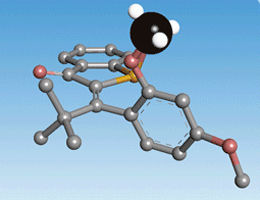Slowing the clockwork of molecular motors
Advertisement
Progress on the way to smart nanomachines: Chemists of Ludwig-Maximilians-Universitaet (LMU) in Munich have modified the synthesis of a molecular motor so as to reduce the speed of its light-driven rotation, thus permitting the researchers to analyze the mechanism of motion in complete detail.
LMU chemists led by Dr. Henry Dube have developed a new method to synthesize a next generation of molecular motors. Using this method "we were able to reduce the speed of our molecular motor sufficiently to allow us following its light-driven rotational motion in complete detail," says Dube, who leads an Emmy Noether Junior Research Group in the Department of Chemistry at LMU.
The new compound, like its predecessor motor molecule contains a carbon-carbon double bond (C=C). When exposed to light, part of the molecule rotates unidirectionally about this double bond. Moreover, unlike most other synthetic motor molecules, which are powered by UV light, Dube's structure can be set in motion by visible light -- which is less energetic than UV. In order to slow down the rate of rotation, Dube and his team developed a new synthesis, which yields the desired structure in five steps. The new approach allows for the incorporation of bulky substituent groups into the final structure, which constrict the path open to the rotor, effectively reducing its mobility and thus leading to a lower overall rotation rate. These modifications allowed the researchers to observe all four of the predicted intermediates that must be sequentially traversed in each rotation cycle, and enabled them to confirm that the motor's mode of rotation is indeed unidirectional.
The goal of Henry Dube's research is to develop the chemical components necessary for the construction of so-called nanomachines - molecular assemblies whose motions and structural states can be controlled by external stimuli. The greater the degree of control achieved, the wider the range of potential applications available. The ability to reduce the rate of rotation of the hemithioindigo motor now opens up possible applications in catalysis or in the development of smart materials, which can be manipulated in a targeted fashion.
Original publication
Other news from the department science

Get the chemical industry in your inbox
By submitting this form you agree that LUMITOS AG will send you the newsletter(s) selected above by email. Your data will not be passed on to third parties. Your data will be stored and processed in accordance with our data protection regulations. LUMITOS may contact you by email for the purpose of advertising or market and opinion surveys. You can revoke your consent at any time without giving reasons to LUMITOS AG, Ernst-Augustin-Str. 2, 12489 Berlin, Germany or by e-mail at revoke@lumitos.com with effect for the future. In addition, each email contains a link to unsubscribe from the corresponding newsletter.































































